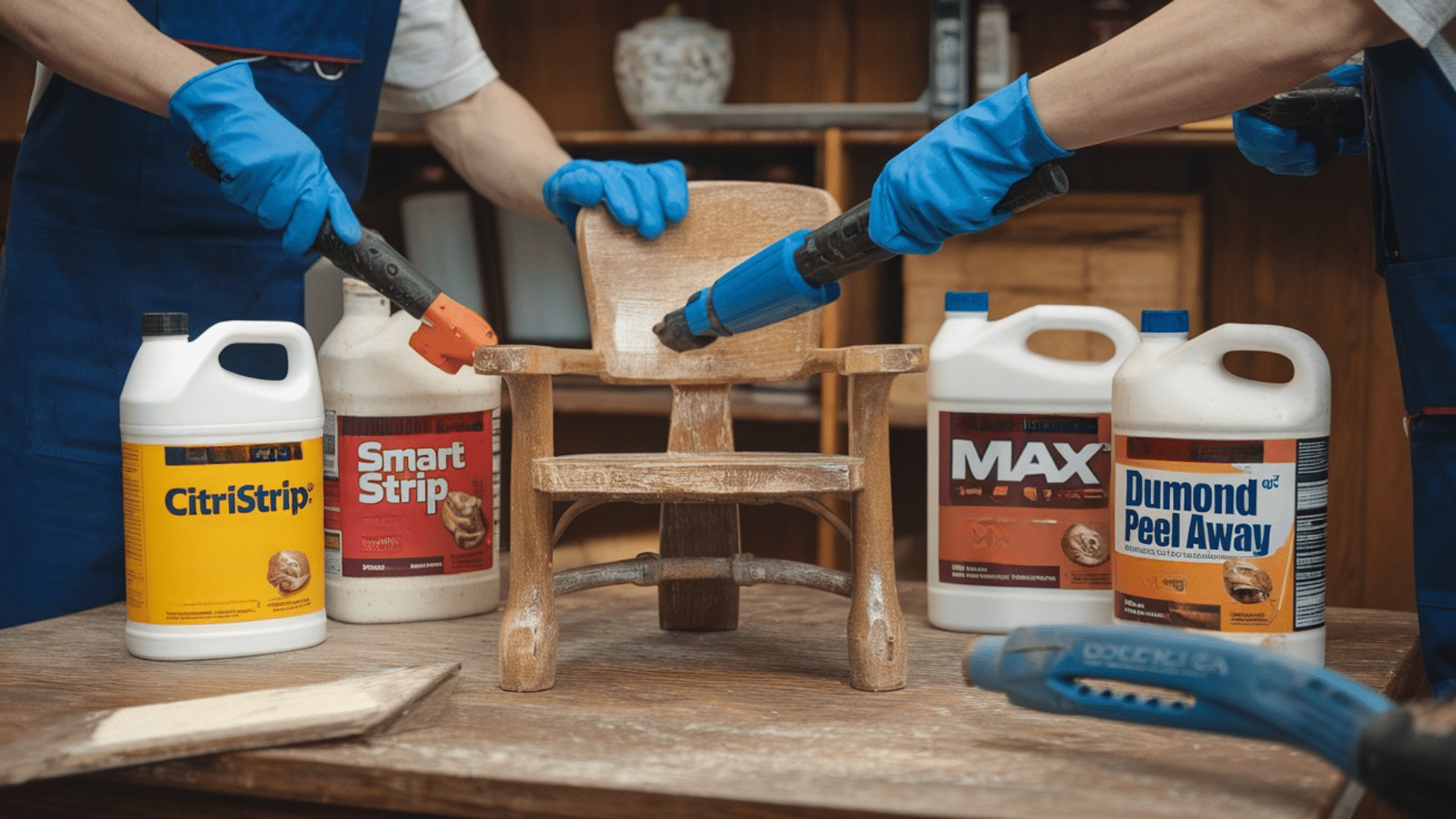Getting old furniture to look new again can be tough.
Paint layers, varnish, and years of grime often hide the true beauty of wooden pieces. I understand how frustrating it feels to try product after product with poor results.
I promise to show you the most useful furniture strippers that actually work on different materials.
These products will help you restore your cherished items without the usual headaches.
This guide will walk you through:
- What furniture stripping really means
- How to pick the right product for your needs
- Top strippers worth your money
- Safety tips for good results
Why Is Stripping Furniture Essential?
Furniture stripping is the process of removing old paint, varnish, lacquer, or other finishes from furniture surfaces. The main goal is to get back to the bare wood or original surface.
People strip furniture when they want to fix damage, update the look, or bring back the natural beauty of older pieces.
The process helps remove years of built-up coatings that might hide the quality of the wood beneath.
Many antique or second-hand pieces have great potential under old, peeling, or worn-out finishes. Stripping lets you start fresh with a clean surface for new paint or stain.
Types of Stripping Methods
1. Chemical Stripping
Chemical strippers use strong formulas to break down old finishes. They come as liquids, gels, or pastes that you apply to the surface. After waiting, the old finish softens and can be scraped off.
These work well for detailed areas but need good airflow.
2. Heat Stripping
This method uses tools like heat guns to warm and soften finishes. The heat bubbles up old paint, making it easier to remove with a scraper.
It works faster than chemicals but can damage wood if the temperature gets too high.
3. Mechanical Stripping
Sanding, scraping, and using power tools fall under mechanical methods. These techniques physically remove finishes through hard work.
Sanding works well for flat surfaces but might be hard for curved or detailed parts.
4. Soda Blasting
This newer method uses baking soda under pressure to remove finishes gently. It’s less harsh than sandblasting and works well for softwoods.
Each method has its place depending on your furniture type, finish, and how much time you want to spend.
Factors to Consider When Choosing a Furniture Stripper
1. Material Compatibility
Different woods react uniquely to stripping products. Soft woods like pine need gentler formulas than harder woods like oak. Check product labels for specific material warnings. Test any stripper on a hidden spot first to avoid damage.
2. Safety and Environmental Concerns
Please look for low-VOC formulas that don’t release harmful fumes. Water-based options tend to be safer for indoor use.
Read warning labels carefully and follow all safety steps. Consider the disposal needs of used strippers and waste materials.
3. Ease of Use and Effectiveness
Some strippers work in minutes, while others take hours to soften finishes. Thicker gel formulas stay put on vertical surfaces better than thin liquids.
Consider how many coats might be needed for full removal. Products with built-in color indicators show where you’ve already applied them.
Top Furniture Strippers on the Market
Review of Popular Products
- Citristrip Paint & Varnish Stripping Gel: This orange-scented gel stays wet and active for up to 24 hours. It works on multiple layers without harsh fumes. Users praise its ability to remove several coats in one application. It performs well on both painted and varnished surfaces.
- Smart Strip Advanced Paint Remover: This water-based formula contains no methylene chloride or NMP chemicals. It can remove up to 15 layers of paint in a single application. The paste-like texture works well on curved or vertical surfaces. Many users note that it’s effective yet mild enough for indoor use.
- Max Strip Paint & Varnish Stripper’s Fast-acting formula shows results in as little as 30 minutes. It handles thick, stubborn finishes that other products struggle with. The product comes ready to use, with no mixing needed. Many woodworkers choose it for tough restoration jobs.
- Dumond Peel Away 1 This system includes a paste and special paper that work together. It excels at removing multiple layers from ornate details, and the unique paper method helps contain mess and fumes. It’s particularly good for antique pieces with many layers.
Key Features and Benefits of Each Option
Citristrip Paint & Varnish Stripping Gel
- Stays active for hours, allowing time to work on large projects
- Pleasant citrus smell makes indoor work more comfortable
- No washing is needed before applying a new finish
- Can be used on wood, metal, and masonry surfaces
Smart Strip Advanced Paint Remover
- Safe for use on many surfaces, including wood, brick, and metal
- Biodegradable formula makes disposal easier
- No harsh fumes means better indoor air quality
- pH-neutral formula won’t damage most woods
Max Strip Paint & Varnish Stripper
- Works quickly, saving time on projects
- Lifts multiple layers in one application
- Clear formula lets you see progress as you work
- Less scraping is needed due to strong lifting action
Step-by-Step Application Process To Use Furniture Strippers Safely?
Step 1: Prepare Your Workspace
Find a well-ventilated area, preferably outdoors or in a garage with open doors. Cover the floor with plastic drop cloths. Remove all hardware from your furniture piece. Set up a sturdy work table at a comfortable height.
Step 2: Clean the Furniture
Wipe down the entire piece with a damp cloth to remove dust and dirt. Let it dry completely before moving forward. This helps the stripper work more effectively on the finish rather than on the surface grime.
Step 3: Apply the Stripper
Pour a small amount into a metal container. Use a natural bristle brush to apply a thick, even coat to the surface. Work in sections of 2-3 square feet. When possible, follow the grain of the wood. Avoid overworking the area.
Step 4: Wait for the Recommended Time
Let the stripper sit according to the product instructions (usually 15-30 minutes). As the finish loosens, you’ll see bubbling or wrinkling. Don’t let it dry out completely. If needed, cover with plastic wrap to prevent drying.
Step 5: Remove the Softened Finish
Use a plastic scraper to lift the bubbled finish gently. Work at a low angle to prevent gouging the wood. Collect the sludge in a disposable container. Use steel wool for crevices and detailed areas.
Step 6: Neutralize and Clean
Follow the product instructions to neutralize any remaining stripper. Often, this means wiping with mineral spirits or water. Let the wood dry completely before sanding or applying a new finish.
Safety Precautions and Protective Gear
Essential protective gear:
- Chemical-resistant gloves (nitrile or neoprene, not latex)
- Safety goggles to protect eyes from splashes
Workplace safety:
- Keep a fire extinguisher nearby, as some strippers are flammable
- Ban open flames, cigarettes, and heat sources from the work area
Health considerations:
- Keep clean water accessible for immediate eye washing if needed
- Have the poison control number (1-800-222-1222) handy
Alternatives to Furniture Strippers
Natural and Eco-Friendly Options
Soy-based strippers offer a plant-derived option that breaks down finishes without harsh chemicals. They work slower but produce fewer fumes. Heat guns provide a zero-chemical method that softens finishes for scraping, though careful temperature control is needed.
Blasting methods gently abrade delicate pieces with walnut shells and baking soda. Steam strippers use only water to loosen old finishes without chemicals.
Citrus-based products harness the power of d-limonene from orange peels to dissolve finishes naturally.
Homemade Stripping Solutions
A mixture of washing soda and cornstarch can form a paste that lifts some light finishes. Apply, let dry, then scrape away. Equal parts vinegar and water warmed and applied to shellac finishes, can soften them for removal.
Boiled linseed oil mixed with rottenstone (fine powder) creates a rubbing compound that removes thin layers of finish through friction. Baking soda paste (mixed with water) works on milk paint when left overnight.
Plain boiling water can remove water-based finishes when carefully applied with clean rags.
Conclusion
Removing old finishes from furniture takes patience, but the results are worth the effort. When you strip away layers of paint or varnish, you reveal the true character of your piece.
We’ve examined different stripping methods, from chemical products to natural options. Each has its place, depending on what you need.
Remember to match your stripper to your wood type. Always wear proper protection. You can test products on hidden areas first.
Whether you choose commercial products or make your own solutions, the key is careful application and proper technique.
Now, you know how to bring tired furniture back to life. Your next restoration project awaits, and your furniture’s hidden beauty is ready to shine again.



















